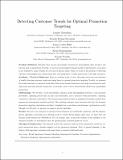Detecting Customer Trends for Optimal Promotion Targeting
Author(s)
Baardman, Lennart; Boroujeni, Setareh Borjian; Cohen-Hillel, Tamar; Panchamgam, Kiran; Perakis, Georgia
DownloadAccepted version (846.4Kb)
Open Access Policy
Open Access Policy
Creative Commons Attribution-Noncommercial-Share Alike
Terms of use
Metadata
Show full item recordAbstract
<jats:p> Problem definition: Retailers have become increasingly interested in personalizing their products and services such as promotions. For this, we need new personalized demand models. Unfortunately, social data are not available to many retailers because of cost and privacy issues. Thus, we focus on the problem of detecting customer relationships from transactional data and using them to target promotions to the right customers. Academic/practical relevance: From an academic point of view, this paper solves the novel problem of jointly detecting customer trends and using them for optimal promotion targeting. Notably, we estimate the causal customer-to-customer trend effect solely from transactional data and target promotions for multiple items and time periods. In practice, we provide a new tool for Oracle Retail clients that personalizes promotions. Methodology: We develop a novel customer trend demand model distinguishing between a base purchase probability, capturing factors such as price and seasonality, and a customer trend probability, capturing customer-to-customer trend effects. The estimation procedure is based on regularized bounded variables least squares and instrumental variable methods. The resulting customer trend estimates feed into the dynamic promotion targeting optimization problem, formulated as a nonlinear mixed-integer optimization model. Though it is nondeterministic polynomial-time hard, we propose a greedy algorithm. Results: We prove that our customer-to-customer trend estimates are statistically consistent and that the greedy optimization algorithm is provably good. Having access to Oracle Retail fashion client data, we show that our demand model reduces the weighted-mean absolute percentage error by 11% on average. Also, we provide evidence of the causality of our estimates. Finally, we demonstrate that the optimal policy increases profits by 3%–11%. Managerial implications: The demand model with customer trend and the optimization model for targeted promotions form a decision-support tool for promotion planning. Next to general planning, it also helps to find important customers and target them to generate additional sales. </jats:p>
Date issued
2020Department
Massachusetts Institute of Technology. Operations Research Center; Sloan School of ManagementJournal
Manufacturing and Service Operations Management
Publisher
Institute for Operations Research and the Management Sciences (INFORMS)